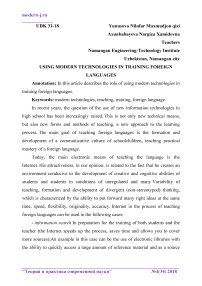Using modern technologies in training foreign languages
Автор: Yunusova N.M., Axunbabayeva N.X.
Журнал: Теория и практика современной науки @modern-j
Рубрика: Основной раздел
Статья в выпуске: 4 (34), 2018 года.
Бесплатный доступ
In this article describes the role of using modern technologies in training foreign languages.
Modern technologies, teaching, training, foreign language
Короткий адрес: https://sciup.org/140272984
IDR: 140272984
Текст научной статьи Using modern technologies in training foreign languages
In recent years, the question of the use of new information technologies in high school has been increasingly raised. This is not only new technical means, but also new forms and methods of teaching, a new approach to the learning process. The main goal of teaching foreign languages is the formation and development of a communicative culture of schoolchildren, teaching practical mastery of a foreign language.
Today, the main electronic means of teaching the language is the Internet. His attractiveness, in our opinion, is related to the fact that he creates an environment conducive to the development of creative and cognitive abilities of students and students in conditions of unregulated and many Variability of teaching, formation and development of divergent (non-stereotyped) thinking, which is characterized by the ability to put forward many right ideas at the same time, speed, flexibility, originality, accuracy. Internet in the process of teaching foreign languages can be used in the following cases:
-
- information search In preparation for the training of both students and the teacher (the Internet speeds up the process, saves time and allows you to cover more sources);An example in this case can be the use of electronic libraries with the ability to quickly access a large amount of reference material and as a source
of didactic and educational-methodological base for its further processing or processing by the teacher;
-
- Synchronous (on-line) or asynchronously (off
line) communication, including native speakers, through communication on the discussion forums and chat rooms, which creates an environment for the formation and development of basic language skills and communicative competence;
-
- distance learning, which becomes a common form of acquisition of knowledge, giving the opportunity to become certified international experts;
-
- testing In real time, available on the websites of language schools and training Web portals, as well as on the servers of educational institutions;
Along with using the Internet, the use of special computer programs becomes an integral unit of the learning process. To this group of technologies you can include such specialized programs as:
-
• computer courses (Reward, The Business);
-
• electronic dictionaries and translators (Macmi llan English Dictionary, Lingvo) ;
-
• Professional software, examples of which include programs such as Power Point, which is used for the preparation of presentations, slide shows and PR-actions, the creation of a portfolio; Adobe Audition, which allows you to improve your phonetic skills and create your own audio texts.
The new educational standards of many universities have already included the mandatory provision of the teaching of foreign languages with innovative technical means, which include interactive whiteboards, projectors, DVDs, video cameras and dictaphones; Allowing to make a variety in the learning process and make it possible to analyze the learning situations by the teacher and by the students themselves.
The current situation dictates not only the use of new technologies in the process of teaching foreign languages, but also requires a change in the methodology of teaching and the ability to introduce the latest innovative technologies in the process of learning foreign languages from the teacher. Using the Internet and other technologies gives great possibilities teacher.
The use of modern technologies, in particular computers, Internet resources, special educational multimedia programs, as well as modern technical means (DVD, video cameras, dictaphones), allows to optimize the educational process in the following areas:
-
- increase of motivation of students and teachers due to active involvement in the process of live communication;
-
- Education of the student's independent personality through the skills to find, evaluate and analyze information;
-
- Intensification of the educational process, which allows rationally organize the educational process, both within the classroom and in the independent work of students;
-
- Development of professional and communicative skills of students and teachers.
-
So, What are the most frequently used elements of the use of information and computer technologies in educational process:
-
• electronic textbooks and manuals, displayed via a computer,
-
• Multimedia projector,
-
• Interactive whiteboards,
-
• Electronic encyclopedias and reference books,
-
• Simulators and testing programs,
-
• Educational resources of the Internet,
-
• DVD and CD discs with pictures and illustrations,
-
• Video and audio equipment,
-
• Interactive maps and atlases,
-
• Interactive conferences and competitions,
-
• Materials for distance learning,
-
• Research projects and projects.
-
• distance learning.
-
• Learn English using and Using Information and computer
Students take great pleasure in the lessons, repeat words, sing songs, perform exercises. The ability to listen to the recording several times, repeatedly perform assignments, and practice at home give the children confidence that everything will work out for them. The use of information and communication technologies help make the lessons more vivid, interesting, and memorable.
Список литературы Using modern technologies in training foreign languages
- Фарходжонова, Нодира Фарходжоновна. "ПРОБЛЕМЫ ПРИМЕНЕНИЯ ИННОВАЦИОННЫХ ТЕХНОЛОГИЙ В ОБРАЗОВАТЕЛЬНОМ ПРОЦЕССЕ НА МЕЖДУНАРОДНОМ УРОВНЕ". Инновационные тенденции, социально-экономические и правовые проблемы взаимодействия в международном пространстве. 2016.
- Kosenkova N.G. Training of teachers of a foreign language using the latest information technologies // IX International Conference-Exhibition "Information Technologies in Education": Proceedings of conference participants. Part II. - Moscow: MEPhI, 1999. P. 270-271.


